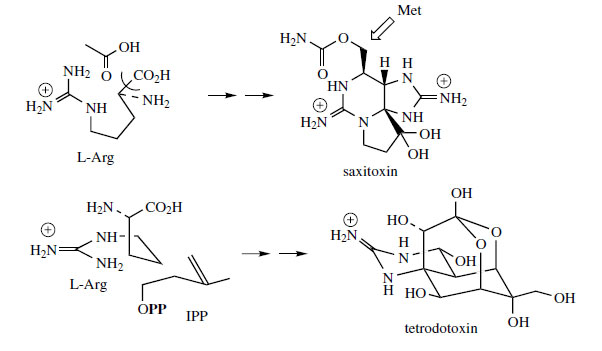Saxitoxin and Tetrodotoxin
The structure of saxitoxin (Figure 136) contains a reduced purine ring system, but it is not biosynthetically related to the purine alkaloids described above. Not all features of its biosynthetic origin have been established, but the amino acid supplying most of the ring system is known to be L-arginine (Figure 136). Acetate and a C1 unit from methionine are also utilized. Saxitoxin contains two highly polar guanidino functions, one of which is provided by arginine, and is a fast acting neurotoxin inhibiting nerve conduction by blocking sodium channels. It is one of a group of marine toxins referred to as paralytic shellfish poisons (PSP) found in a range of shellfish, but ultimately derived from toxic strains of dinoflagellates consumed by the shellfish.Arginine is also a precursor for tetrodotoxin (Figure 136), another marine neurotoxin containing a polar guanidino group. It has been established that the remainder of the carbon skeleton in tetrodotoxin is a C5 isoprene unit, probably supplied as isopentenyl diphosphate (Figure 136).
Tetrodotoxin is well known as the toxic principle in the puffer fish (Tetraodon species), regarded as delicacy in Japanese cuisine. As potent sodium channel blockers, both saxitoxin and tetrodotoxin are valuable pharmacological tools.
 |
| Figure 136 |
Saxitoxin
Saxitoxin (Figure 136) was first isolated from the Alaskan butter clam (Saxidomus giganteus) but has since been found in many species of shellfish, especially bivalves such as mussels, scallops, and oysters. These filter feeders consume dinoflagellates (plankton) and can accumulate toxins synthesized by these organisms, particularly during outbreaks known as red tides, when conditions favour formation of huge blooms of the dinoflagellates. Species of the dinoflagellate Gonyaulax in marine locations, or the cyanobacterium Aphanizomenon in freshwater, have been identified among the causative organisms, and the problem is encountered widely in temperate and tropical areas (including Europe, North America, and Japan). Commercial production of shellfish is routinely monitored for toxicity, which will slowly diminish as conditions change and the causative organism disappears from the water. About a dozen natural saxitoxin-related structures have been characterized, and mixtures in various proportions are typically synthesized by a producer, with the possibility that the shellfish may also structurally modify the toxins further. Acute and often fatal poisonings caused by the consumption of contaminated shellfish are termed paralytic shellfish poisoning (PSP), which involves paralysis of the neuromuscular system, death resulting from respiratory failure. Saxitoxin is a cationic molecule, which binds to sodium channels, blocking the influx of sodium ions through excitable nerve membranes, and is a valuable pharmacological tool for the study of this process. Saxitoxin and tetrodotoxin (below) are some of the most potent non-protein neurotoxins known, and are active at very low concentrations (µg kg−1).
Tetrodotoxin
Tetrodotoxin (Figure 136) is traditionally associated with the puffer fish, Tetraodon species, a fish known as fugu, a highly prized delicacy eaten in Japan. Preparation of fugu is a skilled operation in which organs containing the highest levels of toxin, e.g. liver, ovaries, and testes, are carefully separated from the flesh. Even so, deaths from fugu poisoning are not uncommon, and the element of risk presumably heightens culinary appreciation of the fish. As with saxitoxin, tetrodotoxin appears to be produced by microorganisms, and symbiotic marine bacteria, e.g. Vibrio species, have been implicated as the synthesizers. In addition to fugu, several other species of fish, newts, and frogs have been found to accumulate tetrodotoxin or related structures. The mode of action of tetrodotoxin is exactly the same as that of saxitoxin above, though there are some subtle differences in the mechanism of binding.




